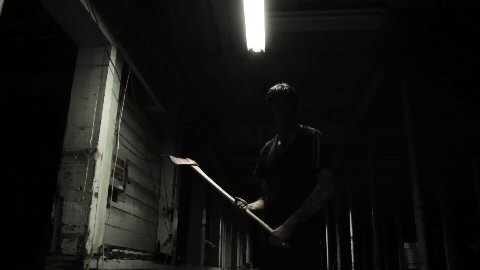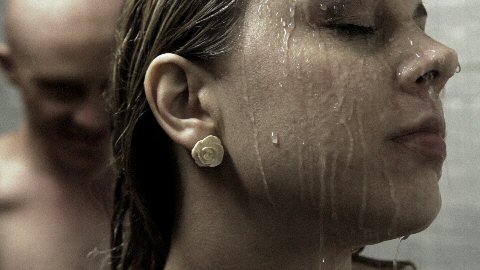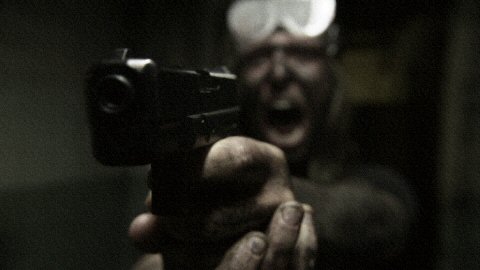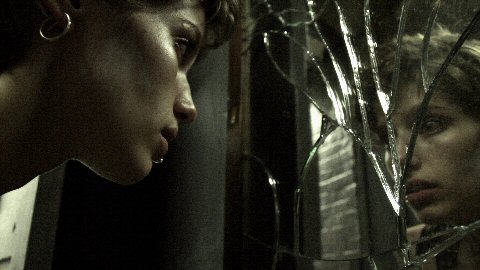Breaking into the film industry can be hard, especially so when you have a clear vision of the kind of movies you want to make. Thankfully, Rasmussen Brothers (Shawn and Michael) worked hard to make their dreams (or should that be nightmares) come true as SGM�s Stuart Willis found when he caught up with the siblings to discuss their latest film DARK FEED and their career to date�

Stuart: Hi, first I'd like to congratulate on your film and thank you for taking the time to chat with SGM. Most people may think your careers began with writing the screenplay for John Carpenter's "The Ward". However, there was a film before that: 2005's "Long Distance". Could you tell our readers a little about this film?
Shawn: It's funny you should ask about that film, because it was our experience on LONG DISTANCE that planted the seeds for DARK FEED. LONG DISTANCE was filmed at night in an abandoned mental hospital in downtown Boston. They shot from 6pm to 6am, and we spent several long nights hanging out on set, watching things unfold.
Michael: To kill time, we would explore the hospital's abandoned wings. The building was literally crumbling around us. And there was old equipment and discarded files all over the place. We quickly realized this needed to be the setting for a horror film.
Stuart: So, how did it come to pass that you ended up working with Carpenter on "The Ward"?
Shawn: We had originally written THE WARD as something we could shoot here in Boston with a very small budget. But our agent really liked the script and thought it could be something bigger. He forwarded it to a company that happened to represent John, and they said they wanted to set it up as his next project.
Michael: Getting that phone call was very surreal. Here was somebody whose films we had admired growing up. They had influenced us as screenwriters and filmmakers. And here he was saying he wanted to make something we wrote.
Stuart: And how involved were you? Did you spend time on the set, develop ideas during production etc?
Shawn: We were fortunate enough to spend three days with John going over the script page by page and discussing what was working and what wasn't.
Michael: John came prepared. He had a stack of research outlining the history of mental illness and hospitalization in the US. It was his idea to have the story take place prior to 1975 because of a landmark court decision that year against involuntary confinement of the mentally ill. He had a very clear image of what he wanted the story to be.
Stuart: How's the big man himself, Mr C? It must've been initially daunting working with a legend of the genre, no?
Shawn: It was very intimidating at first, but John was great. He's very collaborative. He'd make suggestions and then ask what we thought often ending with some sort of crack like, "Listen, I'm just some nobody. You guys are the writers." He's really a very down to earth guy.
Michael: He really challenged us as writers too. He wanted us to think of the script from the director's point of view. As writers, we sometimes lose track of that. We construct these incredibly elaborate scenes with no idea how they will translate from page to screen. John really changed the way we approached that. Now we're always asking, "How the hell are we gonna shoot this?"

Stuart: So would I be right in thinking "The Ward" gave you the break required to secure funding for your own directorial debut, "Dark Feed"?
Shawn: Yes and no. We definitely used THE WARD to help raise money, but most of the investors on DARK FEED were contacts I'd made working in high tech.
Michael: Actually though I think it was more helpful when it came time to market the film. We didn't have any named talent so the fact that we'd written THE WARD really helped open a lot of doors.
Stuart: On paper, "Dark Feed"'s premise will sound familiar to a lot of folk: group of people venture into a disused asylum, murders ensue. What efforts were made to ensure your film offered something different from the norm?
Shawn: We tried to steer clear of stereotypical characters and include set pieces that we hadn't seen before. Like "the hand smoothie" or "the lead actor wearing the leading actress's scalp while motorboating the screenwriter with her implants" sequences. We really tried to push the envelope in that respect. When these characters go crazy, they go bat shit nuts.
Michael: Also it was very important to us that this hospital felt like a living breathing thing. The building needed to be a character. So this idea that there's this dark matter coursing through its pipes like blood through veins was very important for us to convey. To show how it was influencing the people inside it.
Stuart: Working on a budget: what's the most difficult hurdle you had to overcome?
Shawn: Making the film look more expensive that it was. A lot of the effects and set pieces were important to the film. Yet at our budget level, making them look good was a difficult process.
Michael: Also, because you're doing so many different jobs, finding the time to prep was very hard. You're always scrambling to keep up.

Stuart: The building used in the film was a fantastic find - it really does become a character in its own right, and is often genuinely eerie. Could you fill us in a little on its background and how it was found, chosen etc? Is it right that it was also used for Martin Scorsese's "Shutter Island"?
Shawn: The hospital is actually three different locations stitched together. Two of them were used in SHUTTER ISLAND. Ironically each location was found separately. It was just by coincidence that two of them were used in that movie.
Originally we had hoped to shoot in the same building as LONG DISTANCE because we wrote the script with that place in mind. It had everything we had in the screenplay, right down to an empty swimming pool in the basement. Unfortunately in the years since filming there, the structure had decayed so badly that they wouldn't let anybody in there.
Michael: Our primary location Whittenton Mills was a great find. But it was so large you could easily get lost in there. In fact I'm not sure we captured the scope of the place on film. It was quite the maze. It certainly was a creepy environment to shoot in though. Especially since we shot mostly at night, and the mill was out in the middle of nowhere.
A lot of credit goes to our production designer and his team. They built some amazing sets on site like the morgue and the hydrotherapy room that fit so well into the environment that many of the cast just assumed they were part of the place.
Stuart: I found the scene with the transvestite nurse the most unnerving moment in the film. Where did this notion come from, and how was it to shoot?
Shawn: On the set of LONG DISTANCE, one of the actors made a crack about having to get in touch with his feminine side for a part. So when we sat down to write DARK FEED, we thought what if we took that to its furthest possible outcome.
Michael: Michael Reed, the actor who played Jack, really immersed himself in that role. On paper the scene was so absurd, we were worried that it might border on camp when we shot it, but Michael played it with just the right balance to make it believable.
Stuart: Before I watched the film, I had this dread that it was going to be a "found footage" horror. Was it ever a consideration?
Shawn: Early on because of the budget, we had considered shooting the whole thing like one those behind-the-scenes featurettes you find in the special features sections of a DVD menu. But we eventually scrapped that idea and decided to give it a more cinematic look.
Michael: SESSION 9 was a big inspiration for the look and feel we wanted. And we were fortunate enough to have the art director on that film working as our production designer. He was very useful in helping us get that atmosphere.

Stuart: How would you sum up "Dark Feed", thematically?
Shawn: (laughing) Filmmaking is a horror story.
Michael: The process really does push you to the edge, mentally. I think we wanted to capture that in a metaphorical sense.
In the same way that in THE SHINING, Jack's alcoholism makes him vulnerable to the Overlook, it the exhausting filmmaking process that makes the crew vulnerable to this hospital.
Stuart: How has the film been received thus far?
Shawn: Some people seem to get it, and some don't. The thing to remember is that we didn't have a big studio behind us. Or a lot of money. This was just two guys scrapping together all the resources they had at their disposal and calling in a bunch of favors.
Michael: Yeah. We shot this with a crew of five to six people depending on the day. Our cast was mostly made up of college kids just out of school. We were all learning as we were doing. I think a lot of people see the Lionsgate or Anchor Bay logo and think there was a lot of money behind it, but that was not the case. This is the little film that could in terms of finding distribution. And we were very lucky and excited that both these companies took a chance on it.
Stuart: The film has won UK distribution from Anchor Bay, who remain a notable name in terms of genre championing.
Shawn: Absolutely. Having Anchor Bay on board in the UK was a dream come true. Their name is synonymous with the horror genre and we feel incredibly lucky.
Stuart: Is it easier working as a pair? Being partners and siblings must have its pratfalls at times?
Shawn: It's nice to have somebody to bounce ideas off of and lean on for support.
Michael: (laughing) And at times, someone to blame. Seriously though, making a film is a bit like going into battle, and you need to have somebody with you that has your back. Because we're brothers, there's a level of trust there. We can also be brutally honest with each other when it's required.
Stuart: And, what's next? Though your cinematic output thus far has been ostensibly within the horror genre, there are elements of thriller, comedy etc in your screenplays: do you have designs on branching out into different genres?
Shawn: The next couple of projects are very much horror. There are still so many different sub genres that we want to explore. We're currently in post on THE INHABITANTS, which is a throwback to some of those haunted house films from the 70's like THE CHANGELING and HAUNTING OF JULIA.
Michael: We've also got a creature feature in the works and a Lovecraftian nightmare that's certainly unlike anything we've ever seen before. With that said, we're very open to branching out into different genres if the project is a good fit. Horror is our first love though.
Stuart: Thanks a lot guys, and good luck with the film!
DARK FEED is available now from Anchor Bay UK